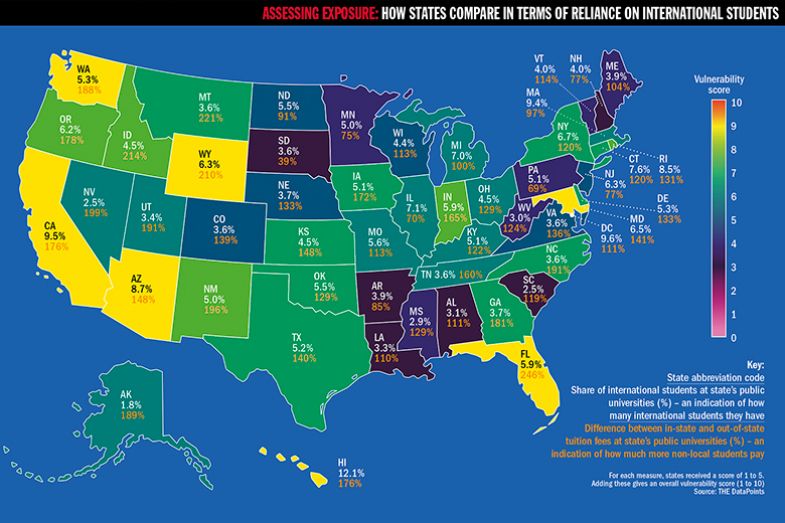View the full results of the Wall Street Journal/Times Higher Education College Rankings 2021
Public universities in California, Florida and Maryland are the most vulnerable financially to a drop in international student recruitment, according to an analysis of data collected by Times Higher Education.
The research, conducted by THE’s data team, used figures on the share of international students and the percentage difference between in-state and out-of-state fees for US public universities as indicators of the amount of additional revenue overseas students bring to campuses compared with local students.
Each US state was given a score of one to five for each of the metrics, based on their average figure, and an overall vulnerability score of one to 10, where 10 indicates the highest level of vulnerability.
While no state received the maximum score of 10, three states were given a nine (when only states where there are data for at least 10 public universities were included): California, Florida and Maryland.
Out-of-state fees in Florida average $16,000 (£12,000), more than three times the price of in-state fees ($5,000), making the Sunshine State the region with the biggest percentage difference between the two fee levels.
California and Maryland also have a relatively big average difference between in-state and out-of-state fees, but their high vulnerability score was driven more by their percentage of international students, 9.5 per cent and 6.5 per cent respectively. In both cases, this share had increased by more than two percentage points in the five years to 2018, more than in any other states, according to the analysis.
At the other end of the scale, public institutions in Alabama, Louisiana and South Carolina are the least vulnerable to a potential drop in international students, each scoring three overall. Louisiana and South Carolina are also among the few states to have faced a slight drop in international students between 2014 and 2018.
The median vulnerability score across the dataset was six.
(Click the map above to view a larger version)
The figures on almost 350 public universities across the country were collected from the US government’s Integrated Postsecondary Education Data System (IPEDS) to create the Wall Street Journal/THE US College Rankings, which were published on the THE website on 7 October.
The US higher education sector is increasingly concerned about a drop in international students driven by the pandemic and the country’s increasingly draconian immigration policies.
Preliminary figures from the National Student Clearinghouse Research Center, published last month, revealed an 11 per cent drop in total foreign student enrolment this year, while a recent survey from the Centre for Global Higher Education found that fewer than one in five students in China – the US’ main source of international students – were interested in studying abroad in the post-Covid era.
Brad Farnsworth, vice-president for global engagement at the American Council on Education, who in August predicted a minimum 30 per cent decline in new international student enrolment this year, said that the Clearinghouse data only show total enrolment and “until we see disaggregated numbers just for new students I’m still very concerned”.
He added that the recruitment figures may be even worse next year, as many overseas students who had applied to start in autumn 2020 “were already locked in when Covid hit”.
Mr Farnsworth said that many public universities in California and Florida were traditionally attractive to international students partly because the states have “for the international community a separate identity” to the US as a whole. Prospective Asian students may have relatives in California, for example, and both states are “culturally much more familiar”, he added.
He said that the two states’ vulnerability to a drop in international students, based on the data, may be compounded by the fact that both regions have been “really struggling with Covid”.
In comparison, New York state, which receives a vulnerability score of seven due to a high share of international students but a small difference in fee costs, is handling the pandemic much better, he added.
Mr Farnsworth said that public universities may be able to recruit more domestic out-of-state students to make up the shortfall of international student revenue, but there were signs that even students within the country had a desire to be less mobile due to the pandemic.
Leonardo Villalón, dean of the International Center at the University of Florida, said he was “extremely concerned” about the decline in the number of international students going to the US and his institution.
He said that last year the university issued 1,700 overseas students who had accepted an offer with documents to get a visa and 91 per cent of those showed up on campus. This year, the university issued about 1,000 students with the paperwork and only 23 per cent enrolled.
He said the pandemic was “a complicating factor” this year but “the policy and political climate is also undoubtedly part of the significant decline”.
“In certain areas and programmes the financial impact of losing international students is extremely significant. That’s especially true in professional master’s programmes,” he added.
Find out more about THE DataPoints
THE DataPoints is designed with the forward-looking and growth-minded institution in view
POSTSCRIPT:
Print headline: Which US states are at risk from overseas student downturn?
Register to continue
Why register?
- Registration is free and only takes a moment
- Once registered, you can read 3 articles a month
- Sign up for our newsletter
Subscribe
Or subscribe for unlimited access to:
- Unlimited access to news, views, insights & reviews
- Digital editions
- Digital access to THE’s university and college rankings analysis
Already registered or a current subscriber? Login









